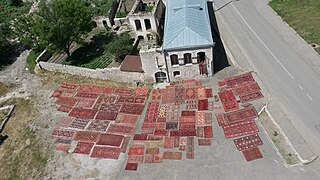Shushi Carpet Museum
Շուշիի գորգերի թանգարան | |
 | |
 | |
| Established | 2011–2013 |
|---|---|
| Location | Yerevan, Armenia |
| Founder | Vardan Astsatryan |
Shushi Carpet Museum (Template:Lang-hy) was founded by Vardan Astsatryan in 2011. The museum opened its doors to the public in 2013, when its location, Shusha (Template:Lang-hy, Շուշի), was under the control of the self-proclaimed Republic of Artsakh.[1]
71 rugs and carpets from the Shushi Carpet Museum are on display in Yerevan at the National Museum-Institute of Architecture after Alexander Tamanyan.[2]
History
The founding private collection included old carpets made by famous Armenian carpet weavers from different villages in Armenia and Nagorno-Karabakh. The collection comprised old Armenian carpets found and bought by its founder, Vardan Astsatryan[3][4].
Until November 1, 2020, the museum had two buildings under its supervision. A fund was established in 2011 by donors from the United States. In 2012, a proper building was designated for displaying the carpets given by donors from Moscow, Russia.[5]
The museum had carpets on display, as well as traditional Historical and cultural artifacts. These artifacts received expert evaluation, underwent restoration and then were put on display.
Until the end of October 2020, the museum consisted of about three hundred (300) carpets and flat weaves. This original collection had dated from the 17th century to the beginning of the 20th century. The majority of the collection presented traditional Karabakh carpet-weaving and Armenian carpet-weaving styles.[6] In addition to the locally woven carpets, there were Turkoman, Afghan and Persian rugs, carpets, and flat weaves in the museum's collection. There were also Russian cultural artifacts in the museum. During his visit to the museum in August 2013, the President of the Republic of Artsakh Bako Sahakyan stated that the carpet museum plays an important role in preserving our national traditions and values and also for the development of tourism.[7]
On October 29, 2020, an explosion of a large rocket, amidst heavy shelling of the city of Shushi (Azerbaijani: Şuşa) by Azerbaijani Armed Forces during the 2020 Nagorno-Karabakh war, damaged the museum buildings. On November 1, 2020, the most valuable items of the collection (about 160 carpets and rugs) were evacuated to Yerevan (Armenia) to avoid further destruction. The remainder of the collection, consisting of 100–120 carpets as well as other cultural artifacts were left in Shusha.[8]
Currently, the collection is on display in the National Museum-Institute of Architecture after Alexander Tamanyan and History Museum of Armenia, both in Yerevan.[9][10]
Gallery
See also
- Shusha Carpet Museum, the Azerbaijani institution which operated in the city from 1985 to 1992
References
- ^ "Carpet museum opens in Shushi". September 12, 2011.
- ^ Harutyunyan, Aneta (February 20, 2021). "armenpress.am". Carpets from Shushi Museum displayed in Yerevan.
{{cite news}}: CS1 maint: url-status (link) - ^ "Շուշիի փրկված գորգերը մշտական հասցե չունեն". «Ազատ Եվրոպա/Ազատություն» ռադիոկայան (in Armenian). Retrieved March 28, 2022.
- ^ "ВЕРНЕТСЯ ЛИ МУЗЕЙ КОВРОВ В АРЦАХ?". golosarmenii.am. Retrieved March 28, 2022.
- ^ "MINISTRY OF CULTURE OF THE REPUBLIC OF ARMENIA "SERVICE FOR THE PROTECTION OF HISTORICAL ENVIRONMENT AND CULTURAL MUSEUM RESERVATIONS" Non Commercial State Organization".
- ^ Hakobyan, Hravard H (1990). The Medieval Art of Artsakh. Yerevan, Armenian SSR: Parberakan. p. 84. ISBN 5-8079-0195-9.
- ^ "Carpet museum opens in Shushi". October 22, 2013.
- ^ Շուշիի գորգերը արկերից փրկվել, Երևան են հասել։ Լրաբեր – 20.21.2021, retrieved April 2, 2021
- ^ "Քույրերի օժիտի, շվեդ զբոսաշրջիկի և Շուշիում "իրար գտած" 150-ամյա գորգի մասին․ "Խճանկար"". Հայաստանի Հանրային Ռադիո (in Armenian). Retrieved April 2, 2021.
- ^ "ՀԱՅԿԱԿԱՆ ԳՈՐԳԱՐՎԵՍՏ XIV – XX ԴԴ – HMA" (in Armenian). Retrieved April 2, 2021.
Further reading
- Mozaffari, Ali; Barry, James (2022). "Heritage and territorial disputes in the Armenia–Azerbaijan conflict: a comparative analysis of the carpet museums of Baku and Shusha". International Journal of Heritage Studies. 28 (3). doi:10.1080/13527258.2021.1993965.











